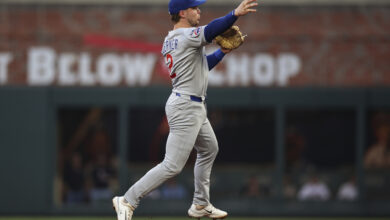
Quick Thoughts on Cubs Pitching Infrastructure Following CubsCon
Cubs Convention is still going strong as I type this, but I’m already back home after a three-hour trek back from my truncated stay at the annual fan fest. It’s always an interesting time for me because I really dig how the baseball energy is so strong even in the middle of frozen-ass January, but the real value comes from conversations other than those taking place on stage during the myriad panels. I mean, there’s only so much salient information you’re going to get from Jed Hoyer and Carter Hawkins in a public setting.
That’s why it’s so great to catch up with and pick the brains of people like Marquee’s Lance Brozdowski or The Athletic’s Sahadev Sharma. The highlight for me was chopping it up with Tyler Zombro, who frequent readers know I’ve been fanboying over since the Cubs added him to the front office several weeks ago. He was part of a pitching panel moderated by Alex Cohen that took place in a smaller room and also included assistant pitching coach Casey Jacobson and relievers Eli Morgan and Rob Zastryzny.
Much of the audience consisted of young kids and their parents, so I didn’t feel it would be in my best interest to get really granular by asking about the best pitch types and shapes based on arm slot and motor preference. I was, however, able to gather that the Cubs are indeed leaning into the general concept of MP and applying it to their pitching development. More specifically, they’re working to enhance their pitchers’ strengths by better tailoring their repertoires to their individual styles.
Some folks may think it’s odd to cut back on trying to improve weaknesses, but it makes all the sense in the world when you think about it. These guys made it to pro ball because of what they do well, so why de-emphasize that or try to add something that might not actually work well for them? That’s why Justin Steele, a heavy supinator, has indeed scrapped the more traditional circle change he’d been throwing pretty fruitlessly in favor of a split grip he doesn’t have to force himself to try and get on top of.
Zastryzny is also a supinator and likewise changed his offspeed grip to a two-seam orientation in order to take advantage of seam-shifted wake. He opted against a kick-change due to his age and role, as he really doesn’t have time to perfect something new. The 2016 World Series champ did share, however, that he believes the kick will be the changeup in baseball within five years.
I’d theorized on that to an extent, at least as far as the Cubs are concerned now that Zombro is in the mix. Though he’s not technically a member of the coaching staff, the former pitcher and Tread instructor is working closely with Jacobsen and Tommy Hottovy on various aspects of pitch design and programming. For now, Zombro’s focus is primarily on player acquisitions. That means bringing Zastryzny back to give the Cubs a lefty specialist who’s really good at making the ball go right and targeting Morgan as a changeup specialist who, unlike the other guys we’ve discussed, is a pronator.
Then you’ve got very direct Tread ties with minor-league signee Ben Heller and trade acquisition Matt Festa. The Cubs also signed undrafted free agent Jordan Goldmann following a Tread pro day performance that showed him flashing mid-90s velocity after having sat upper 80s in college. Tread announced Saturday afternoon via Instagram that the Cubs have also signed Cole Reynolds, a 6-foot-5 lefty out of Elon University and UNC Charlotte. Keep an eye out because I’d wager those aren’t the only two guys we’ll see added to the organization from that pro day.
That’s not just a theme for the Cubs, as many teams are seeing tremendous value in poaching instructors and signing players from Tread, Driveline, and other such outfits. Rather than taking their time with projects, MLB teams can just let third parties do the heavy lifting to turn overlooked pitchers into dudes. And though most front offices are somewhat risk-averse by nature, bringing in experts from cutting-edge facilities allows them to up their internal knowledge with different points of view.
This has been my favorite trend of the offseason by far and it’s something we’re likely to see expanded over time as the Cubs and other orgs seek to better analyze data in service of performance.

